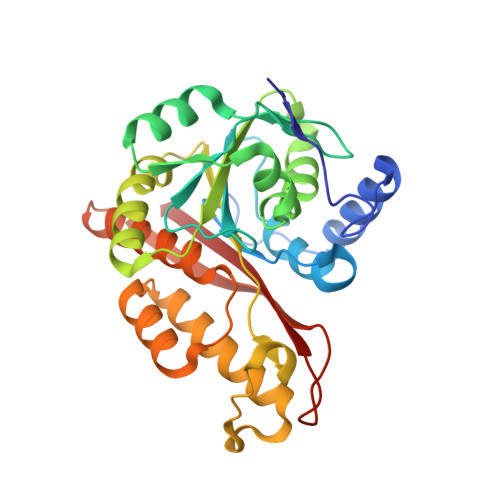MEMO1 binds iron and modulates iron homeostasis in cancer cells.
Dolgova, N., Uhlemann, E.E., Boniecki, M.T., Vizeacoumar, F.S., Ara, A., Nouri, P., Ralle, M., Tonelli, M., Abbas, S.A., Patry, J., Elhasasna, H., Freywald, A., Vizeacoumar, F.J., Dmitriev, O.Y.(2024) Elife 13
- PubMed: 38640016
- DOI: https://doi.org/10.7554/eLife.86354
- Primary Citation of Related Structures:
7KQ8, 7L5C, 7M8H - PubMed Abstract:
Mediator of ERBB2-driven cell motility 1 (MEMO1) is an evolutionary conserved protein implicated in many biological processes; however, its primary molecular function remains unknown. Importantly, MEMO1 is overexpressed in many types of cancer and was shown to modulate breast cancer metastasis through altered cell motility. To better understand the function of MEMO1 in cancer cells, we analyzed genetic interactions of MEMO1 using gene essentiality data from 1028 cancer cell lines and found multiple iron-related genes exhibiting genetic relationships with MEMO1. We experimentally confirmed several interactions between MEMO1 and iron-related proteins in living cells, most notably, transferrin receptor 2 ( TFR 2), mitoferrin-2 ( SLC25A28 ), and the global iron response regulator IRP1 ( ACO1 ). These interactions indicate that cells with high-MEMO1 expression levels are hypersensitive to the disruptions in iron distribution. Our data also indicate that MEMO1 is involved in ferroptosis and is linked to iron supply to mitochondria. We have found that purified MEMO1 binds iron with high affinity under redox conditions mimicking intracellular environment and solved MEMO1 structures in complex with iron and copper. Our work reveals that the iron coordination mode in MEMO1 is very similar to that of iron-containing extradiol dioxygenases, which also display a similar structural fold. We conclude that MEMO1 is an iron-binding protein that modulates iron homeostasis in cancer cells.
- Department of Biochemistry, Microbiology and Immunology, University of Saskatchewan, Saskatoon, Canada.
Organizational Affiliation:





















